We take a brief look at automotive repair focusing on restoring lost mileage.
Your customer has been diligently tracking miles driven, and how much gas was put in their tank. He’s even gotten himself a note pad with his favorite sports car on the cover to write it down and keep track of his economy. Then it happens, out of the blue, his calculator tells him that he has lost 5 miles to the gallon since his last fill up. What happened? Where did the gas go?
In today’s environmentally aware culture we understand that loss of fuel mileage means more pollution in the air, and more cost at the gas station. What may be missed is that it also means something may be, at least to some degree, failing with the vehicle. Much the same as a person who develops excessive thirst may see a doctor, excessive fuel consumption will likely need the help of a diagnostic technician. The difficulty of these diagnostics can range from simple things the driver should be checking to the advanced internal workings of the transmission. To top things off, there may often be more than one issue causing the problem.
When diagnosing poor fuel economy there is a very large gap in the diagnostic chain. An experienced diagnostic technician knows you should first verify the customer complaint. Unless you plan on running a couple of tanks of fuel through the car during your testing, that’s going to be difficult to do. Without verification you are going to have to rely heavily on your customer’s observation of the problem. The nice thing is that people that will complain about a fuel mileage change are also the ones keeping track of their fuel mileage.
Start by listening carefully to your customer. Sudden changes in mileage are often attributed to changes in driving situations. Don’t assume your customer is aware that vehicles get different mileage on the freeway as opposed to city or rush hour traffic. According to fuelmileage.gov as much as a 33 percent mileage reduction can be simply explained by driver attitude. Careful and tactful interrogation is important to make sure you are looking for a problem under the hood and not just a loose nut in the driver’s seat. With any luck your customer can help keep you from looking for a problem that simply isn’t there.
As an example, a grandmother is giving her Sentra to her grandson for a graduation present. Mysteriously the car loses 20 percent of its fuel economy and the tires and brakes are worn out after a few thousand miles. She brings the car in on his behalf and wants you to find out what’s wrong with the car. Common sense tells us we don’t need to spend a ton of time on this one, but don’t just dismiss it either. Although poor alignment and sticky brake calipers can cause a significant drop in mileage, youth and testosterone most certainly will cause a drop in mileage.
Considering how the vehicle is being used can also be a direction to investigate. An extreme case might be someone that just got a new job delivering anvils, or just got a shiny new roof rack to hold their mountain bikes. The effects of these changes will vary greatly between vehicles. What might make a significant difference in a Sentra might make less of a difference in an Altima and almost no difference in a bigger vehicle like a Quest.
Assuming you have considered all the external causes and you are convinced there is something wrong with the vehicle, it’s time to start narrowing down the possible causes. Test driving on surface streets as well as the highway is a good idea to cover as many angles as possible. A rough idle at a stop light might indicate poor spark plug condition or poor compression, whereas poor power on the freeway may indicate a weak coil or a variable valve timing malfunction. Poor yet smooth acceleration may indicate a slipping transmission or even a faulty torque converter. This is also a good time to take stock of the warning indicators on the dash.
When an engine is brand new it will have less mileage as it breaks in. The mileage will get better and better, possibly for even tens of thousands of miles. At some point it will reach its perfect break-in point. After this point it will very slowly decrease in efficiency as the engine slowly wears down and loses volumetric efficiency. Just as the many other parts of the vehicle can wear out, once an engine reaches 2 or 3 hundred thousand miles it will start to wear out, no matter how well it is maintained. A leak-down test can identify if the mileage has taken its toll on the engine’s performance.
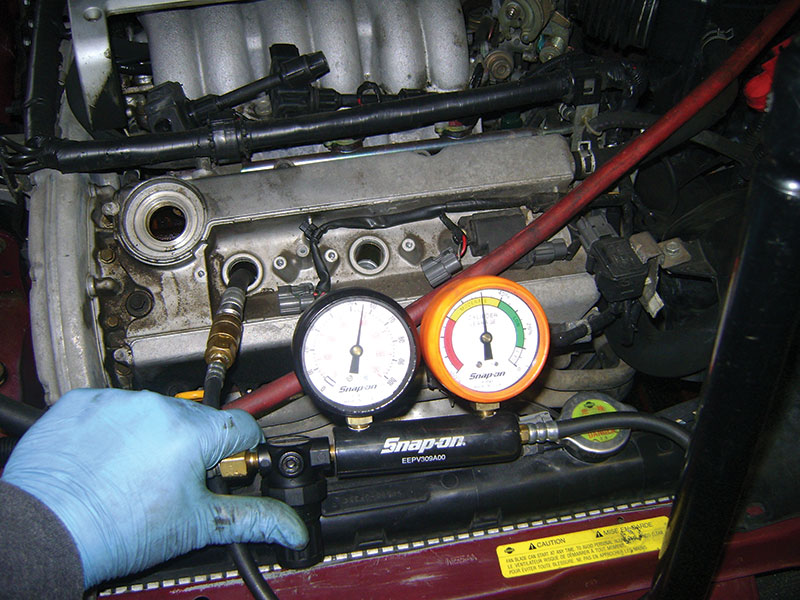
At 300K miles this engine isn’t going to get the mileage it once did. With air hissing in the crankcase it’s going to need a rebuild to get its former glory back.
Engine and transmission trouble codes will often lead to fuel robbing malfunctions. Something as simple as a P0442 EVAP small leak code can lead you to a leak in the fuel system. Gas dripping on the ground does not help your mileage. Sometimes codes can still lead you to fuel waste even if they don’t seem, on the surface, to be related.
Take for example a P0420 code, catalytic converter below efficiency. Seldom does a catalytic converter cause any noticeable driveability issue, but it can still be an indication of a fuel/air mixture problem. Although converters do fail from old age they are much more likely to fail from an overly rich condition or even excessive hydrocarbons in the exhaust from a partial misfire. Although this would be a great time to hook up your scanner and take a look at the fuel trims, it may not give you the entire picture. Since the ECM gets its fuel trim data by reading the oxygen sensors, keep an open mind about the readings you get.
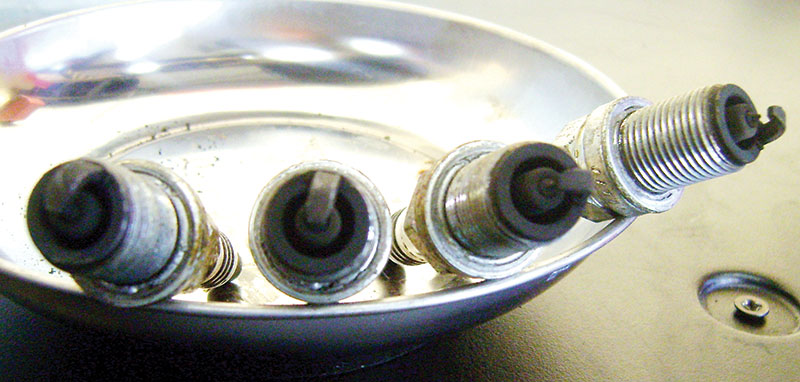
These plugs are clearly getting too much fuel, yet the fuel trims on this 1997 Maxima still showed a lean condition.
Oxygen sensors can send false readings to the ECM for various reasons. A leak in the exhaust upstream of the pre-cat oxygen sensor can make it seem that the exhaust is leaner than it actually is, or a failing sensor may read lower than it should. Since the computer has no other way to tell, it assumes the engine is lean and needs more fuel, thus causing an excessively rich condition and a significant loss of fuel economy. A solid way to verify a condition like this is to use a 5 gas analyzer or even just take a look at a spark plug. Black soot on the plug indicates too much fuel. Often you can even smell richness in the exhaust. If the fuel trims don’t agree it’s time to investigate the oxygen sensors.
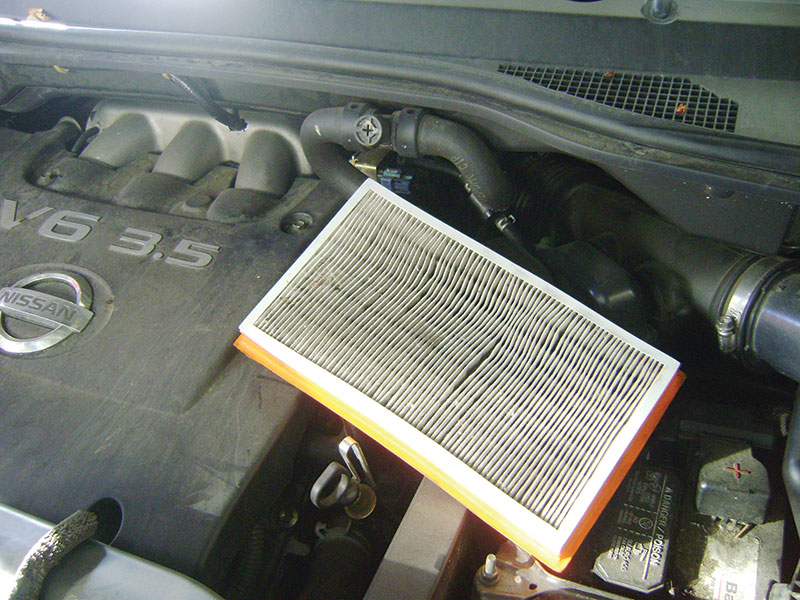
As the air filter gets dirty the air pressure builds and starts to deform the filter material. It’s time to replace this filter.
Another common cause of fuel mileage woes rests in the transmission. Scanning for codes in the transmission may reveal the culprit. Codes for the torque converter clutch like P0744 or P0740 indicate that the torque converter is still slipping when you should have direct power transfer through the converter. In city or stop and go traffic you may not see any difference in mileage. At higher speeds it can really start to add up since a torque converter typically slips about ten percent at highway cruising speed without the torque converter clutch locking up properly. Other systems can also prevent lockup as well. A low coolant temperature sensor, inaccurate input or output speed sensors, or even a faulty TPS signal can also prevent the TCC from locking up.
Unfortunately not all issues will have a bright light on the dash to point you in the right direction. Often a simple lack of maintenance is at fault. 20,000 miles overdue for replacing spark plugs can result in reduced efficiency. 5,000 miles overdue on an oil change can result in a loss of the friction-reducing properties of the oil and a reduction in mileage, not to mention engine life. Failing to change a dirty air filter is a very common oversight that can add up to inefficiency. Any of these items may not be enough to raise any eyebrows, but together they can easily add up to a loss of as much as 5-10 mpg. Getting the maintenance up to date should at least help if not solve the fuel mileage problem.
Engine performance issues are not always the root cause of mileage loss. Brakes, alignment, and tires also play a role. According to fueleconomy.gov you can expect about 0.2 percent mpg loss per 1 psi average pressure drop across all four tires. Using the tire pressure recommendations on the driver’s door jamb is your best bet for setting the correct pressure. Lower than recommended pressure will decrease efficiency, but don’t assume the opposite is true. Inflating the tires to maximum pressure won’t necessarily add the same fuel mileage that a low tire takes away. More importantly, over inflated tires decrease traction and stability.
Very intelligent engineers from Nissan, the tire manufacturers, and several organizations like the Tire and Rim Association (TRA), have already done the leg work and figured out the perfect compromise between safety, performance and fuel mileage. Taking their recommendation is the right call and you can find that recommendation in the driver’s door jamb on almost any modern vehicle.
Alignment can have surprisingly strong effects on mileage. For every 1/8th inch of toe there is the same force as dragging the tire sideways 28 feet for every mile driven. As you can imagine, the action of removing rubber from the tires as it’s dragged sideways takes a lot of energy that ultimately comes from the gas tank.
Getting the front toe as close as possible to zero would seem to be the easy answer, but it’s not. The specifications for setting toe are designed to be used when the vehicle is sitting still on the alignment rack, not as it’s driving down the road. Drag on the front tires and pull from acceleration can change the actual toe under various driving conditions. Same as tire pressure, following the set specifications is the best bet. To a lesser degree, caster and camber can have an effect as well. If there’s enough energy to pull the vehicle off its straight path, that force has to come from somewhere.
When a customer has a problem with the brakes they will most likely notice some other symptom before they notice any change in fuel mileage. For the sake of thoroughness, though, we should consider a couple of issues that may present a problem in the braking system.
A really good practice, whenever you are doing any kind of brake work, is to check the temperature of the brakes at each wheel with an infrared temperature sensor. Each axle should have a relatively minor temperature difference side to side. More than a 20 percent difference indicates that one side is working too hard or the other side isn’t working hard enough.
There should be a difference between the axles, with the rear being cooler than the front to varying degrees depending on the weight of the vehicle and the weight balance. Patterns that may warrant a closer look as a culprit for a mileage decrease might be warmer rear brakes or warmer diagonal brakes. Either of these patterns may not cause a noticeable pull to either side while driving and yet still cause enough drag to kill fuel economy. Simply raise the vehicle off the ground and spin each tire by hand. Any excessive drag will be obvious.
Keep in mind when looking for a fuel mileage complaint, as with any complaint; verify the customer’s concern. Sometimes people have unrealistic expectations of what kind of mileage they should get. Take for example a customer who comes in with a 2004 Maxima and he is just distraught that he is only getting 27.7 mpg. If he’s doing any city driving you might have some difficulty improving on that since the rating for this car is 20 mpg city and 29 mpg highway.

At nearly 28 mpg this Maxima is getting great gas mileage. The driver reports a lot of highway driving.
People get the impression that a V-6 Maxima and 4 cylinder Sentra are about the same size and made by the same manufacturer so they must get similar fuel efficiency, when the reality is as much as a 40 percent difference in these two 2004 models. It wouldn’t be a bad idea to start any service regarding fuel mileage expectations with a quick search of the manufacturer’s estimated city and highway mpg rating.
Cars are engineered very well these days. If all the systems are functioning properly, it is unlikely they will suffer poor fuel economy. Of course, if the vehicle is not configured as it was designed to be run, all bets are off. Aftermarket performance ECMs, cold air intakes, oil filled air filters, and other performance parts can make a big mess of things. Many performance parts can ruin the fuel mileage only to gain very small horsepower improvements.
One example is a system that connects inline with the coolant temperature sensor. The device sends erroneously low temperature readings to the ECM, tricking it to run richer at full temperature. The increased fuel may slightly increase power but will dramatically reduce mileage. Should you find these kind of devices installed, they are a good place to look for the lost mileage.
One last very notable fuel economy problem is the type of fuel going into the tank. E85 fuel is available in most states now and most manufacturers including Nissan have flex fuel vehicles available. Unfortunately mileage while using E85 fuel will suffer a lot. Some estimates are as much as 30 percent less fuel economy.
To add to that news, the lower price of E85 will often tempt people to use it even if they don’t have a flex fuel vehicle. This can manifest itself in a Check Engine light with codes for a lean condition. Some have claimed that the high ethanol content makes it more corrosive and may damage rubber and aluminum parts in the fuel system. The important thing for this conversation is that if your customer is using E85 they will have a loss of fuel economy.
Although finding fuel mileage problems can cover a broad range of systems, they don’t have to be scary problems to diagnose. If there is truly one problem causing the mileage loss it will not be hiding. It is more likely you will find several smaller issues working together. If your test drive doesn’t reveal a problem and your inspection doesn’t turn up anything obvious, think outside of the box a little. Significant weather changes and seasonal fuel blends can have an effect on mileage. Construction in the area may cause more stop and go traffic. A cold turn in the weather combined with a remote start system could be other things to consider.



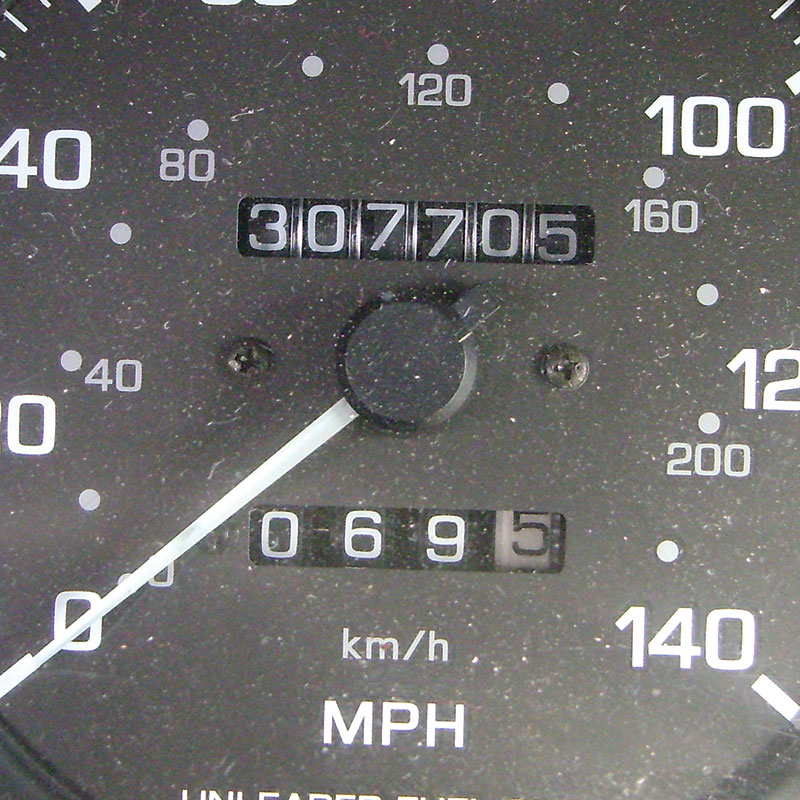
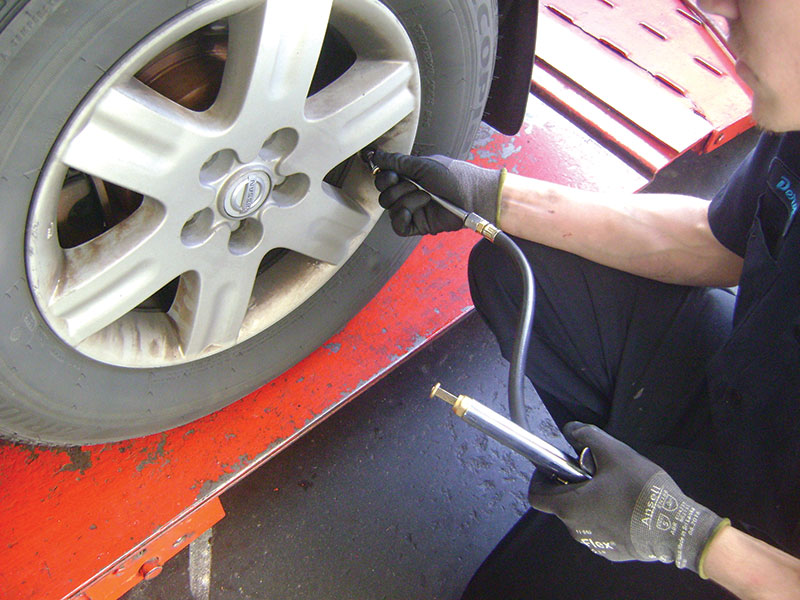
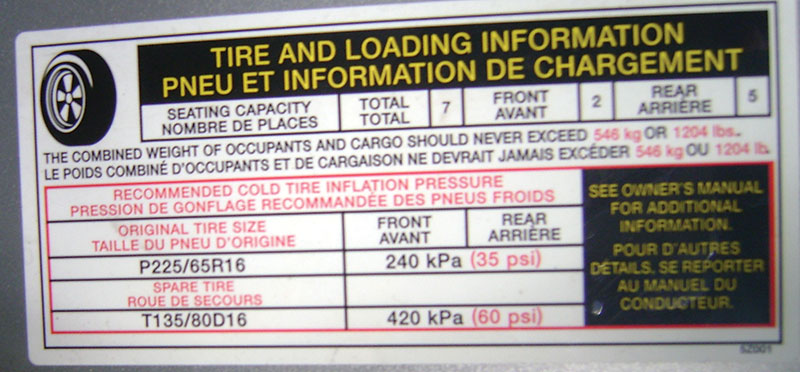




0 Comments